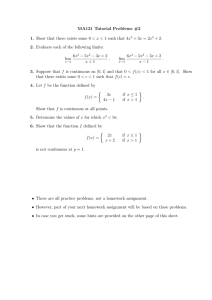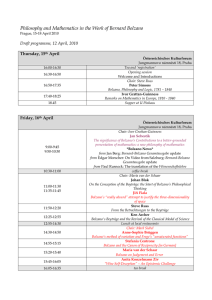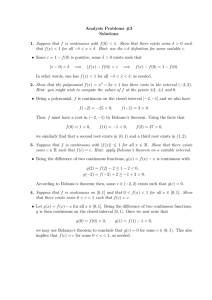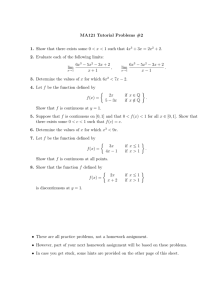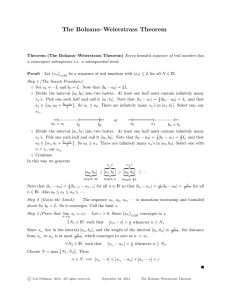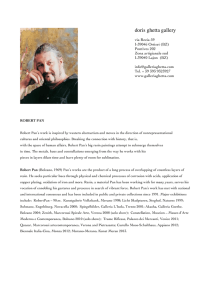Jan Sebestik Contributions to a better-grounded : a new philosophy of mathematics
advertisement
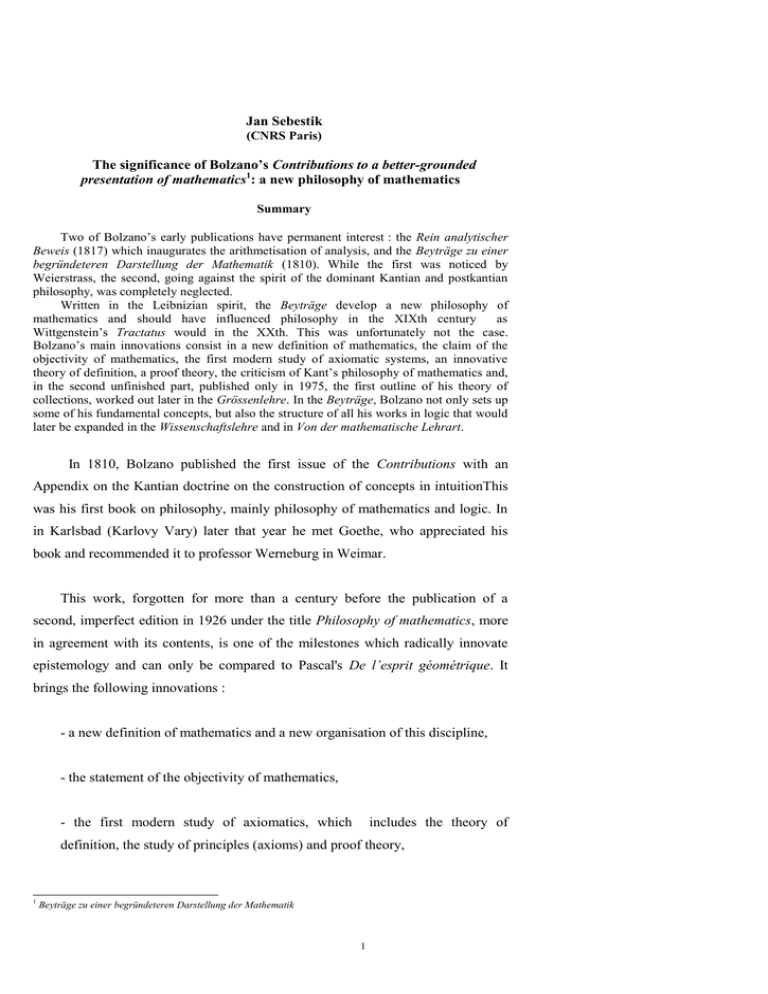
Jan Sebestik (CNRS Paris) The significance of Bolzano’s Contributions to a better-grounded presentation of mathematics1: a new philosophy of mathematics Summary Two of Bolzano‘s early publications have permanent interest : the Rein analytischer Beweis (1817) which inaugurates the arithmetisation of analysis, and the Beyträge zu einer begründeteren Darstellung der Mathematik (1810). While the first was noticed by Weierstrass, the second, going against the spirit of the dominant Kantian and postkantian philosophy, was completely neglected. Written in the Leibnizian spirit, the Beyträge develop a new philosophy of mathematics and should have influenced philosophy in the XIXth century as Wittgenstein‘s Tractatus would in the XXth. This was unfortunately not the case. Bolzano‘s main innovations consist in a new definition of mathematics, the claim of the objectivity of mathematics, the first modern study of axiomatic systems, an innovative theory of definition, a proof theory, the criticism of Kant‘s philosophy of mathematics and, in the second unfinished part, published only in 1975, the first outline of his theory of collections, worked out later in the Grössenlehre. In the Beyträge, Bolzano not only sets up some of his fundamental concepts, but also the structure of all his works in logic that would later be expanded in the Wissenschaftslehre and in Von der mathematische Lehrart. In 1810, Bolzano published the first issue of the Contributions with an Appendix on the Kantian doctrine on the construction of concepts in intuitionThis was his first book on philosophy, mainly philosophy of mathematics and logic. In in Karlsbad (Karlovy Vary) later that year he met Goethe, who appreciated his book and recommended it to professor Werneburg in Weimar. This work, forgotten for more than a century before the publication of a second, imperfect edition in 1926 under the title Philosophy of mathematics, more in agreement with its contents, is one of the milestones which radically innovate epistemology and can only be compared to Pascal's De l’esprit géométrique. It brings the following innovations : - a new definition of mathematics and a new organisation of this discipline, - the statement of the objectivity of mathematics, - the first modern study of axiomatics, which includes the theory of definition, the study of principles (axioms) and proof theory, 1 Beyträge zu einer begründeteren Darstellung der Mathematik 1 - a presentation of logic with several new rules of inference, - in the appendix, a criticism of Kant‘s philosophy of mathematics, written by a philosopher who is at the same time a working mathematician, - and in the second issue, unfinished and published only in 1977, a first draft of a theory of collections under the title Mathesis universalis (allgemeine Mathesis). The years of Bolzano‘s public activity were also a period of intense theoretical work, philosophical, mathematical, theological and socio-political, which is reflected by his publications, manuscripts and the notebooks Philosophische Tagebücher and Miscellanea Mathematica. The Contributions consist of two parts: I) the concept and division of mathematics, II) on the mathematical method. For Bolzano, a presentation of the mathematical method is essentially nothing other than logic and not itself part of mathematics; in fact, it precedes mathematics. The title of the Contributions reveals the importance that Bolzano attaches to the rules of exposition of sciences. All his works on logic exhibit the same structure and the same headings: the last paragraphs of On logic (Etwas aus der Logik) as well as On the mathematical method recall these rules, by means of which Bolzano will define the ultimate goal of the Theory of science: to present the rules ―by which we must proceed in the division of truth generally into particular sciences and their exposition in their own treatises‖— in brief, how to ―present the sciences in scholarly books suited to their purpose‖ (transl. B. Terrell, p. 38). The reader recalls Pascal‘s art of persuasion, which consists in ―the conduct of perfect methodical proofs‖ (L’art de persuader, Paris, Seuil, 1963, p. 356). Despite the strong presence of Kantian themes and concepts – e .g. the definition of analytical judgements and the declaration that the concept of representation is the most general concept – one feels that with his affirmation of the objectivity of logic and mathematics, Bolzano is already opposed to Kantianism. His masters in the field of theory of science are Aristotle, with his distinction between the proofs that show that something is (Bolzanian certifications) and those which show at the same time why it is so (Bolzano's objective groundings), Leibniz with his Dissertation on the combinatorial art, the 2 Dialogue on the connection between things and words, the New essays on human understanding and the idea of mathesis universalis which encompasses all a priori sciences, and Euclid (in spite of Bolzano's strong disagreement with the Euclidean order of theorems), ―whose treatise is in a certain sense still unequalled‖. Bolzano begins the Preface of the Contributions by enumerating the defects of fundamental concepts of mathematics at the beginning of he XIXth century. Even the definitions in arithmetic, ―by far the most perfect of the mathematical disciplines‖, are imperfect. The definition of negative numbers is faulty, not to mention irrational and imaginary (= complex) numbers (Bolzano thinks of complex numbers as empty concepts, but would later accept them as symbolical statements about real quantities). The presentations of the foundations of the infinitesimal calculus are uncertain and even contradictory. The state of geometry is even worse: it lacks definitions of such fundamental concepts as those of line (and of the straight line), surface and solid; a serious deficiency can be found in the theory of parallels (Bolzano thinks that the Euclidean postulate should be demonstrated by means of the principle of similarity); but above all, the Euclidean order or rather disorder should be replaced by first stating the axioms that contain only simple subjects and predicates and then proceeding step-by-step using definitions. The objective geometrical order should begin with the concepts of point, line, distance, direction etc. and only thereafter should we proceed to objects such as triangles, circles, etc. The situation in mechanics is similar with the concepts of speed and force, etc. What is mathematics? Following Kant, in 1810 Bolzano rejects the traditional definition of mathematics as science of quantity, because in many mathematical problems, e.g. those of combinatorics or of geometry, quantities are not involved. But Bolzano strongly disagrees with Kant, who based mathematics on constructions of concepts in pure intuition (= in the forms of intuition that are time and space); according to the latter, such constructions are the warrant for the existence of mathematical objects. For Bolzano, the concept of pure intuition is simply contradictory and neither pure universal mathematics, nor geometry requires intuition. For Bolzano, the existence of a mathematical object equals the possibility (i.e. the noncontradiction) of its concept. As simple concepts cannot contradict themselves and 3 axioms are composed of simple concepts, mathematical existence equals possibility equals non-contradiction2. What, then, is mathematics? It is a ―science that treats general laws (forms) to which the things must conform in their existence‖ (Contributions, I, § 8, p. 109). Bolzano adds that his definition applies to all things whatsoever, both physical and purely mental such as intuitions and ideas (representations). What are those general laws and their relation to forms? By forms, Bolzano understands whole species of objects, i.e. wholes, classes. The laws would then govern the behaviour of wholes and of their parts. Such a law is e.g. countability, according to which it is possible to compose or unite equal parts of a thing. Later formulations indicate that mathematics studies the co nditions of possibility of things, e.g. all possible configurations of a collection of objects, while metaphysics deals with the ―proofs of actual existence of certain objects – liberty, God, immortality of the soul - from a priori concepts‖ (Contributions, II, § 9). Mathematics and metaphysics are thus two branches of a priori knowledge : mathematics considers actually existing things, but deals only with hypothetical necessity, while the task of metaphysics, in contrast to Kant, consists in giving the proof of the necessary existence of some of these things: God, freedom of will, immortality of the soul. A new organisation of mathematical disciplines Bolzano‘s definition of mathematics yields a new way oforganising its disciplines. According to the Euclidean scheme, there are two branches of mathematics: arithmetic and geometry. For Bolzano, these are not on the same level, because their objects do not have the same generality. The object of pure or universal mathematics, mathesis universalis, is the thing in general (Ding überhaupt); its laws apply to all things without exception. For the first time in the history of mathematics, the disciplines of pure mathematics are established. The Purely analytical proof enumerates them explicitly: arithmetic, algebra and analysis. This reversal of the order of disciplines has far reaching consequences: on the one hand, geometry, the paradigm of deductive method since Antiquity, becomes part of applied mathematics; it consists in applying pure mathematics to space. On the other hand, disciplines which only acquired a well-defined status in the XVIIth and XVIIIth centuries, such as algebra, the infinitesimal calculus, and of course arithmetic, form the fundamental disciplines yielding fundamental concepts for all of mathematics. This reversal of the order and the downgrading of 2 This is a bit hasty. 4 geometry implies the need to set up new proofs of old theorems: everywhere where geometrical proofs of theorems of analysis were considered satisfactory, new, purely analytical proofs and new concepts belonging to pure mathematics will be necessary. Gauss and Bolzano will be the leading figures in this movement of arithmetisation of analysis, followed by Cauchy, Abel and others. Objectivity of mathematics ―In the realm of truth, i.e. in the collection of all true judgements reigns a certain objective connection, independent from our contingent recognition of it, in virtue of which some of these judgements are grounds of others, while those are their consequences‖ (II, § 2). This is a declaration of war on Kant and all subjectivist philosophers, for whom truths and especially scientific and mathematical truths are Menschenwerk, having their origin in the particular capacity of the human mind that organises our perception and knowledge. (Cf. Descartes: mathematical truths are such as they are because they are created by a free decree of God; Leibniz: they are truths of reason created by God). According to Kant, mathematics cannot be applied to things in themselves, because we have no knowledge of them. In his later works, WL and Paradoxes of the infinite, the theologian Bolzano advocates the most radical theory of independence of truths from God who, instead of having created them, can only recognise and accept them. The doctrine of the objective connection of truths is the seed from which all of Bolzano's logical theories will grow. It means that the real purpose of a scientific exposition is the organisation of truths according to objective dependence, and not simply certainty and strength of conviction. In the WL, Bolzano will represent this dependence by means of proof-trees whose origin are the axioms (such trees will appear in logic only in the middle of the XXth century). The partition of truths in two classes – axioms and theorems – is for Bolzano objective, given once for all, and the goal of our science consists in discovering it. The objectivist attitude is manifest in Bolzano‘s criticism of geometrical constructions. For him, these are just illustrations of theorems and proofs, important for pedagogical reasons and for facilitating better insight into the detail of arguments, but proofs must be conducted by purely conceptual means. Contrary to Kant for whom mathematical objects exist only when they are constructed, for 5 Bolzano, the existence of mathematical objects results from the compatibility of concepts that define them. Theory of definition Definitions are decompositions of a given concept. For Bolzano, each concept has a unique definition; if we begin with with different constituents we in fact define another concept. But we cannot define all concepts: pursuing our effort of definition, we arrive eventually at simple, undefinable concepts. How can we understand them? How can we grasp the sense of our theories if all their concepts are based on simple concepts? The most important innovations of the Contributions concern his theory of definition and axiomatics. Let us look briefly at the history of the classical theory of definition with its three milestones : Aristotle, Pascal and Bolzano. For Aristotle, a definition is the statement of the essence of things. Pascal first imagined that the ideal theory would be that in which all concepts could be defined, but immediately realised that this goal is impossible. His way out consists in declaring simple, undefinable concepts to be self-evident, so they do not need to be defined. Bolzano tackled the problem of the impossibility of defining simple concepts : if all concepts are defined (=decomposed) in terms of simpler concepts, how can we understand the undefinable, absolutely simple concepts? ―But how does [the mathematician] begin to reach an understanding with his readers about such simple concepts and the words that he chooses for their designation?' This is not a great difficulty. For either his readers already use certain words or expressions to denote this concept and then he need only indicate these to them, e.g.; 'I call possible that of which you say that it could be', or else they have no particular symbol for the concept he is introducing, in which case he assists them by stating several propositions in which the concept to be introduced appears in different combinations and is designated by its own word. From the comparison of these propositions the reader himself abstracts which particular concept the unknown word designates. So, for example, from the propositions: the point is the simple [object] in space, it is the boundary of a line and itself no part of the line, it has neither extension in length, breadth, nor depth, etc., anyone can gather which concept is designated by the word 'point'. This is well known as the means by which we each came to know the first meanings of words in our mother tongue. 6 Moreover, since concepts which are completely simple tend to be used only rarely in social /108/ life and thus either have no designation at all, or only a very ambiguous one /note: the concept of point/, then in a scientific exposition which begins with simple concepts it is anything but superfluous first to explain the particular designation for these concepts in one of those two ways. To distinguish such explications from a real definition we could call them designations or descriptions. They also belong to the class of conventions, in so far as they are intended only to supply a certain concept with its particular symbol. They would thus be the first thing with which any scientific exposition must begin in so far as it has simple concepts.‖ (Contributions, II, § 8, Russ p. 107). According to this text, we cannot decompose simple concepts, but we can arrive at an understanding of signs that designate them. This happens in following steps: 1) We learn the meaning of words designating simple ideas exactly like we learn our mother tongue; 2) We do it by abstracting their meaning from different true sentences (circumlocutions, paraphrases) containing their signs; 3) In the WL (IV, § 668, 548), Bolzano recommends grouping these sentences, ―so that the reader can grasp the [simple] concept from their comparison‖. This is still not exactly what we really need, but it is a radical break with all thinkers who rely on intuitive understanding, evidence or illumination, and it points unambiguously in the right direction. In all his works, Bolzano considers the problem of simple concepts as the problem of understanding the signs that designate them and thus allow us to identify them. In the WL, it is a problem treated under the heading of semiotics. Another step is necessary: we have to consider that we can extract the meanings of the signs designating simple concepts only if this meaning, i.e. the concepts themselves are determined (or codetermined) by these propositions, independently of the relation between signs and concepts, regardless of our effort to understand which simple concept is attached to a sign. Bolzano never explicitly accomplished this step. Nevertheless, it would not only be in perfect harmony with the theory of propositions-in-themselves, but we are in fact compelled to accomplish it, if instead of considering the explication of a sign, we look at its meaning in itself, i. e. the simple concepts themselves in their propositional context3. So we have the right to state: 7 5) The axioms of a theory determine the simple concepts which they contain. Moreover, for the first time in the history of science and epistemology, we do not have two parallel expositions, one on definitions, the other one on axioms, but one self-contained complete account of axiomatics: the simple concepts are embedded in the axioms which ‗define‘ them exactly as paraphrases and circumscriptions define in use the words of common language that we do not understand. Bolzano‘s concept of explication (Verständigung) applied to simple concepts is perhaps the most important single achievement of the Contributions. In the WL and in the Mathematical method, Bolzano gives a more precise formulation: in order to grasp the simple ideas, ―[W]e set out various propositions in which the concept designated by our sign appears in such combinations that no other concept could be thought in its place if these propositions were to express something reasonable. By considering and comparing these sentences the reader will gather by himself the meaning of our sign.‖ (On the Math. Method, tr. P. Rusnock and R. George, p. 57-58; my emphasis). Several years after the Contributions, others – J. D. Gergonne (implicit definitions), Jeremy Bentham (paraphrases), Poincaré (definitions in disguise) and Hilbert (axioms define the primitive terms), to name just the most important – present similar theories that will become, in spite of Frege‘s and Russell‘s objections, standard axiomatic procedure. Axiomatics and proof theory The goal of a scientific exposition is to present the objective connection of true judgements (in the WL: of truths-in-themselves). By this expression, Bolzano understands the deductive structure of a theory whose theorems are not only logically derived from previous theorems and eventually from the axioms (principles), but that are moreover grounded in them. The beautiful proof-trees in the WL illustrate this objective logical structure. In a way reminiscent of Aristote's division of proofs into proofs of the mere fact and explanatory proofs, Bolzano divides proofs into certifications and grounding proofs. Both have their place in science, but an exposition that presents truths scientifically must proceed by means 3 I owe to the critical remarks of Paul Rusnock a better insight (I hope) into the problems of explication (Verständigung). 8 of grounding proofs (in his mathematical works, Bolzano always tries to ground, begründen, his theorems). Hence there are two main problems: 1) how to divide the truths of a theory into two classes: axioms and theorems, 2) how to decide, between different equivalent partitions (those that yield the same stock of theorems) and between different equivalent logical derivations, which one best corresponds to the unique objective logical structure. Before Bolzano, the criterion for the choice of axioms was a maximum of intuitive clarity and evidence. But such criteria are for Bolzano subjective: they admit degrees, depend on circumstances and vary from person to person. In an axiomatic theory, the choice of axioms cannot be dictated by their evidence or certainty. Bolzano invokes the authority of Euclid, who undertook to prove even the most evident theorems when he was able to. Bolzano thinks that Euclid stated his parallel postulate only because he did not know how to prove it (for Bolzano, the Euclidean postulate cannot be a postulate or axiom: it contains a defined notion, that of parallel, and is too complex, while axioms have simple subjects and predicates). An axiom in the objective sense is ―a truth which not only we do not know to prove, but which is in itself unprovable‖ (Considerations, II, § 11). To solve the first problem, the choice of axioms – or rather their discovery – Bolzano explains the concept of proof, enumerates the rules of inference corresponding to the relation of ground and consequence and examines the difference between analytic and synthetic propositions. What is a proof? It is a sequence of judgements and inferences that allows one to know a truth and which makes it evident, einleuchtend. Bolzano does not define the ground-consequence relation, but having stated it, he gives a list of the simple and independent logical rules of inference. We may thus conclude that the grounding relation consists in a logically correct inference of a truth according these rules from premises which are in themselves and necessarily the grounds of the conclusion. These rules of inference are so to speak the embryo of his logic of the consequence (Abfolge) developed in the WL. There is just one simple independent syllogistic rule, barbara; according to Bolzano, all other syllogistic forms either are not essentially different from barbara, or are not simple: S is M M is P S is P. 9 Bolzano then introduces new rules of inference that contain the conjunctions and and cum: A is (or contains) B, A is (or contains) C A is (or contains) [B and C] A is (or contains) M, [A and B] is (or contains) M B is (or contains) M A is (or contains) M, [A cum B] is possible, or A can contain B [A cum B] is (or contains) M. On the other hand, perfectly valid inferences such as [A et B] is (or contains) M A is (or contains) M B is (or contains) M are not instances of the consequence relation, because the premise is not in itself the necessary ground of the two conclusions (Bolzano will admit it in the WL, II, § 222, p. 388). The ground-consequence relation proceeds from the simpler to the more complex: in the four inference rules, the complexity grows as we progress from the premises to the conclusion. This idea will serve as vital thread for the theory of Abfolge in the WL. In the Contributions, Bolzano develops ideas about scientific proofs already expressed in his Considerations about some objects of elementary geometry of 1804: one must use all the elements of the statement of the theorem during the proof, and one should not introduce concepts foreign to the field of enquiry (= the Aristotelian command no “metabasis eis allo genos”, no transition to another species). He notices that Lagrange deduced one of his fundamental analytical theorems from a property of continuous curves, thus from a geometrical consideration, while it is precisely the continuity of the function that guarantees the continuity of the corresponding curve. 10 In all his works, Bolzano pays great attention to apagogical (indirect) proofs, proofs by reductio ad absurdum, where the conclusion is obtained in proving that the opposite hypothesis leads to a contradiction. For him, proofs that use contraposition as well as proofs that infer the true proposition A is B from the false premise A is not B, are not genuine apagogical proofs. Such proofs conclude from the contradiction obtained from the false premise A is not B that A is B. In the Contributions, apagogical proofs are essentially necessary only to prove negative propositions. Let us return to axioms, objectively unprovable true propositions. It is indisputable that there are axioms, because the existence of an infinite sequence of consequences without first and absolute grounds is absurd and contradictory. Bolzano even pretends that ―even if one does not find [this contradiction], it is necessary to think it as actual‖ (II, § 13). Bolzano still did not finish the preliminary enquiry before treating the problem of criteria of axioms. He has to explain the nature and the different kinds of judgements. What is a judgement? It is not enough to define it as a combination of concepts or ideas, because a combination of concepts can result either in a complex concept or in a judgement. These two kinds of combination correspond to two different simple operations of our mind; the latter joins two concepts by means of a copula.4 In the Contributions, Bolzano rejects the reduction of all judgements to one canonical form (he would later reverse his position in the WL) and tries to classify the judgements precisely according to the nature of the copula. Altogether, he distinguishes the following kinds of judgements: 1) judgements of necessity, whose form is S is a kind of P (extensional version) or S contains the concept P (intensional version),5 2) judgements of possibility: A can be a kind of B, 3) judgements of obligation or duty, practical judgements: N should do X, 4) judgements of perception, empirical judgements; I perceive X, 5) judgements of probability or of experience, 6) judgements of causality (added in the second issue, § 2): A is a cause of B Now, Bolzano takes over the Kantian classification of judgements into analytic and synthetic. Analytical judgements cannot be axioms, because they do not contain any 4 In the Philosophische Tagebücher, Gesamtausgabe 2 B 15/2, p. 221, Bolzano notes an idea of Tietze who wants to abolish the copula in judgements. Bolzano rejects it, noting that the expression ‗Caius mortal‘ is not a judgement, because to form a judgement, it is necessary to have « a new concept, that of inclusion of a species or an individual in a genus‖. Nevertheless, in Russian, the copula, although mentally present, is almost always absent in the expression of such judgements: Mertvyi chelovek means a dead man, but etot chelovek mertv means this man is dead. 11 information. Even worse, they are not even judgements because they do not assert anything; they are just sentences. Axioms are necessarily synthetic judgements and axioms a priori cannot contain more than three simple parts: subject, predicate and copula. Having shown that there are synthetic judgements (such are for example the judgements whose subject is simple), Bolzano eventually sets out criteria for unprovable, primitive judgements. The first condition is negative: judgements whose subject or predicate is complex are always provable. In II, § 20, Bolzano discusses in detail the conditions of simplicity of axioms and arrives at the conclusion that all axioms must have simple subjects and predicates. He adds another important observation that we shall find in the works of XXth century logicians: if A is B is an axiom, one has to show that there is no pair of propositions of the form A is X and X is B from which A is B could be deduced. The justification of axioms demands a specific procedure which Bolzano calls, following Kant, deduction (I shall use the Latin term deductio in order to distinguish it from logical deduction). The deductio is an essential part of scientific exposition. It cannot be a proof of the axioms, because there are no premises from which the axioms could be deduced. It is a metatheoretical reflection which guarantees that the axioms are really the ultimate unprovable truths as well as the foundations of the whole scientific system (such a reflection is also necessary in order to justify the simplicity of primitive concepts). The axioms are not necessarily better known than the theorems; their function is purely logical, allowing to deduce and to ground all theorems. Let us sum up the main points of Bolzano‘s theory of axiomatics. The existence of simple, undefinable concepts presupposes the existence of synthetic judgements a priori, especially the existence of axioms that define them contextually. As an a priori theory grows, its concepts and theorems become increasingly complex. Bolzano‘s conception is based on the belief in the uniqueness of the chain of definitions and uniqueness of the grounding relation and perhaps also in the uniqueness of the whole logical structure of the theory (slightly liberalised in the WL). Such a belief would have been difficult to justify even at the beginning of the XIXth century (cf. for example Leibniz continually looking for alternative formulations of his logical calculi). Bolzano develops his theory of the objective connection of truths based on the grounding relation in the WL without really attaining his goal, but the idea of an architectonic scientific system governing the logical derivations and proofs has reappeared in the recent works of contemporary logicians (Michael Detlefsen, Jacques Dubucs with Sandra Lapointe). Our theories do not lay claim 5 In the second Issue of the Contributions, Bolzano prefers to call them judgements of subordination; they include judgements of subsumption. 12 to uniqueness, but the idea of axioms implicitly defining their primitive concepts has become a standard procedure in axiomatics. Appendix: Bolzano’s critique of Kant’s philosophy of mathematics As Bolzano himself states in an appendix to his Autobiography, ―In Kant‘s Critique of pure reason, which he began to study in his 18th year, from the very beginning he liked the distinction between a priori and a posteriori judgements, between analytical and synthetic judgements, and the classification of ideas (representations) into intuitions and concepts, although he never managed to agree with the definitions given by Kant […] In particular, he never believed that the synthetic judgements of arithmetic are founded on the intuition of time and that [in geometry] it is permissible, according to the Euclidean manner, to trust what can be seen. He could not accept this, because he soon found a way to deduce from concepts several geometrical truths previously known only through sight.‖6 In the Contributions, Bolzano takes up several Kantian concepts while criticising the fundamentally subjectivist orientation of their author. He adopts Kant‘s definition of analytical judgement and the definition of intuition as singular idea (in the WL intuition is defined as simple singular idea). He uses the Kantian concept of deductio in the sense of justification. He agrees with Kant about the synthetic nature of most mathematical judgements. Nevertheless, critical remarks are scattered through the Contributions: Bolzano does not accept phoronomy (= kinematics) as an independent science, has doubts about the a priori deduction of the law of gravitation, refutes the trichotomic division of the table of categories and even rejects the table as a whole, as well as the Kantian definitions of judgement. The main objection to Kant, however, concerns his subjectivism, with the idea of the construction of concepts in pure intuition. Kant and Bolzano differ radically on the question of the existence of mathematical objects: while for the former, the objects result from a construction, for the latter, their existence consists in the compatibility of the components of their concepts. Kantian constructions take place in pure intuition, i.e. in the forms of sensibility, namely space and time. Except for some intuitionists, few mathematicians have accepted time as a necessary condition for the foundation of arithmetic. 6 Gesamtausgabe 2 A 12/1, p. 67-68. 13 The example of addition in arithmetic shows that no intervention of time and no intuition is necessary in order to prove a formula like 5 + 2 = 7. Leibniz tried to prove it by using only definitions and Kant could point out the gap in Leibniz‘ derivation so that the intervention of intuition seemed justified. Against Kant, Bolzano was able to complete the Leibnizian proof and showed that addition is based on the associative law, which is purely conceptual. But are not intuitions and images essential at least in geometry? As in the example of arithmetic, they seem necessary only because they fill gaps in proofs. In Euclid‘s geometry the images should not be parts of the proofs. Moreover, some geometrical objects and operations cannot be adequately represented by an image. This is the case already for the simplest geometrical object, the point. No image can represent an infinite straight line. In the WL and in the New Anti-Kant, Bolzano and Příhonský show that the Kantian schemata which are supposed to provide rules for the construction of images are nothing else but genetic definitions, i.e. concepts that describe the formation of their objects. For Bolzano, the concept of pure intuition is simply contradictory and in no case can it provide what it promises: constructions in pure intuition produce only individual objects, which should represent all individual objets. How is this possible? How can Kant arrive at universal validity from singular objects and judgements? Bolzano‘s response is final: we achieve universality ―only by means of what is general, namely by means of a concept and not by means of intuition‖ (Appendix, § 1). The second issue of the Contributions: first concepts of the future set theory After the publication of the first issue of the Contributions, Bolzano prepared the second issue under the title Universal mathematics, but did not finish it. In this manuscript, he tries to determine the frontiers of this discipline and further develops his criticisms of Kant. Let us return to his definition of mathematics as the science of laws governing all things without exception: which are the laws that ―to which the things must conform in their existence‖? The question falls within the province of ontology which has, according to Wolff, ―to prove the attributes of all beings (entia) either absolutely or under a certain condition‖ (Ontologia, Prolegomena § 8). Bolzano finds two such laws, but before quoting them, I shall examine with him the principles that are claimed to be universal. First, he excludes the logical principles of non-contradiction, excluded middle, and identity, because they are analytical and even identical judgements. In an important 14 observation, Bolzano explains the difference between identity and equality: when one says that a thing is equal to itself, ―it would be actually more correct to say that every thing is identical to itself. When we have two ideas (representations) of the same thing and do not know that they are ideas of the same thing, we suppose first that there are two things, called for example A and B; later we find that A and B are identical‖ (Ibid., § 13). Frege will illustrate Bolzano‘s observation with the example of Morning and Evening star. Let us now consider genuine ontological principles. The principle of universal determination is true of every object, but Bolzano reduces it to the principle of excluded middle ―Everything is A or non-A‖. The different versions of the principle of sufficient reason are all inadequate. Kant limits its use to phenomena, but, as Bolzano remarks, he tacitly assumes it in claiming things in themselves to be the ground of phenomena. This principle is for Bolzano simple, undefinable and its validity is limited. Other principles (axioms) do not depend on further reasons; moreover, free actions are not determined by sufficient reasons and even the existence of God has no sufficient reason. From his analysis Bolzano draws a radical conclusion: there is no principle of sufficient reason having universal validity, because there is no universal procedure to decide if such and such thing has a sufficient reason. Other principles and maxims are objects of Bolzano‘s criticism: the principle of similitude and the scholastic maxim of the immutability of things. He then returns to Kant, reviews the table of the principles of understanding, which he claims do not belong to universal mathematics because their domain of validity is limited. Let us notice his critical remark on the Kantian concept of possibility. Bolzano agrees with Kant that possibility (and other modal notions) does not contain a new determination of the concept to which it is appended. It has another role, namely to express the formation of a concept. To say ―a right-angled triangle is possible‖ means to say that a triangle can be rightangled. Thus, the concept of possibility is not a predicate, but a copula. The concept of possibility turns into an attempt to construct a complex concept, an attempt that can produce an authentic concept, but that also can fail and result in a bare accumulation of signs having no sense. In this text, even Wolff‘s example of a bi-angle (a figure enclosed by two straight lines) does not designate a concept (but we understand what it should be, J.S.) ; in the WL and later works, such expressions designate objectless concepts, as opposed to bare accumulations of signs like x/: . 15 What, then, are the principles of universal mathematics or, in Husserl's terms, of formal ontology? There are two: 1) the law of the possibility of ―thinking-together‖ (Zusammendenkbarkeit) several things, according to which any thing can be joined in thought to any other thing, and 2) the law of relation, stating that any thing has a certain relation to every other thing (Bolzano says almost nothing about this second law). These two laws govern only our ideas, they are not valid for the things themselves and their existence. In another wording, ―all things can be ideally united‖, the first law is very close to Cantor‘s much later and far more famous definition of a set: ―By set, we understand any union (Zusammensetzung) M of definite and well distinguished objects m of our intuition or of our thought to be conceived as a whole‖. Bolzano calls the results of such union a whole (ein Ganzes) or a system and sometimes also a sum (in his later works, Bolzano prefers the term collection, Inbegriff) and the things united in a whole its parts (Teile). No homogeneity of parts is necessary to form a whole; so, to cite some extreme cases, it is possible to unite a candle (a real thing) and a syllogism (a sequence of propositions-inthemselves) in a whole (On the mathematical method and Correspondence with Exner, p. 142 and 160), and the Paradoxes of the infinite (§ 3) give as examples the collection formed by a rose and the concept of rose, and another one containing the name of Socrates and a definite description of him. It is important, too, to keep in mind that a whole can have aninfinity of parts, for example the whole consisting of the points of a line. For two reasons, Bolzano‘s wholes cannot be immediately identified with our sets: 1) because they have a certain structure, 2) because the concept of part is not well defined. To determine a whole means to determine both the parts and the manner of their connections. Bolzano‘s universal mathematics contains the seminal idea of whole or system that would later be developed. Already in his Dissertation on the combinatorial art (1666), Leibniz postulated that it is possible ―to take together simultaneously (simul sumere) any objects and to suppose that they form a whole‖, but the idea of whole or system that could have its place in mathematics disappeared from the horizon of mathematicians. Bolzano‘s seminal idea brings it back. Throughout his scientific career, Bolzano will not only use it, but will consider it to be the fundamental concept of mathematics: numbers are certain collections and all geometrical objects are collections of points. The way that Bolzano uses the concept of collection and multitude in the Theory of functions is exactly the same as in the works of Weierstrass and of his school. Even if the title of mathesis universalis does 16 not appear in the Theory of quantity, the concepts of collection, system, sum, multitude and set will be elaborated into a proto-theory of collections. In its most accomplished form in the Theory of quantity, it contains under the heading theorems two fundamental principles of Cantorian set theory: the extensionality principle governing sets (Mengen) and the comprehension principle. The most important insight of the Paradoxes of the infinite, a book carefully studied both by Cantor and by Dedekind, states the characteristic property of infinite sets, its reflexivity (existence of a 1-1 correspondence between a set and one of its proper subsets). Dedekind would later turn this property into a definition of infinite set. Conclusion Although still endebted to Kant and adopting some of his important distinctions, in the Contributions Bolzano is already moving in the opposite direction, stressing the objective character of human knowledge and the logical structure of science. In this work, which should have influenced XIXth- century philosophy as Wittgenstein‘s Tractatus influenced that of the twentieth-century, Bolzano puts forward his main themes and concepts: the objective connection between truths based on the concept of grounding, the two kinds of proofs: certifications and grounding proofs, the idea of contextual definition, a refutation of Kant‘s philosophy, especially of his philosophy of mathematics based on the contradictory concept of pure intuition. In opposition to Kant, Bolzano founded his philosophy on logic, whose central idea is that of proof. This conception showed soon its fruitfulness in his works on the infinitesimal calculus: in the Purely analytical proof and in the Theory of Functions. Both introduced new rigor, new arithmetico-analytical methods and new concepts, preparing way for the school of Weierstrass. The recognition of his logic came only in the XXth century when Tarski and Carnap elaborated logical semantics. The seeds of these developments lie in the small booklet published here in Prague exactly two hundred years ago. 17 18


